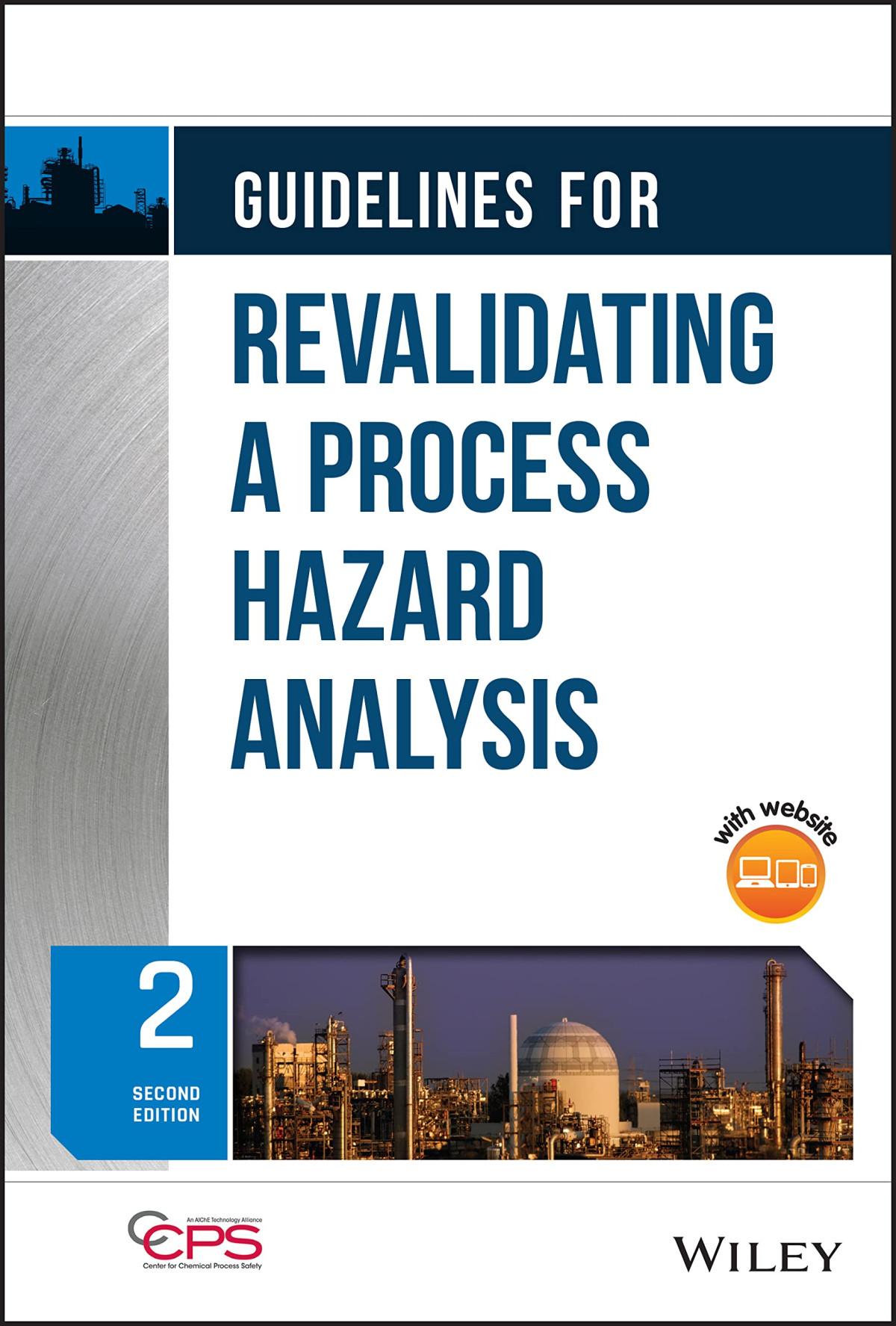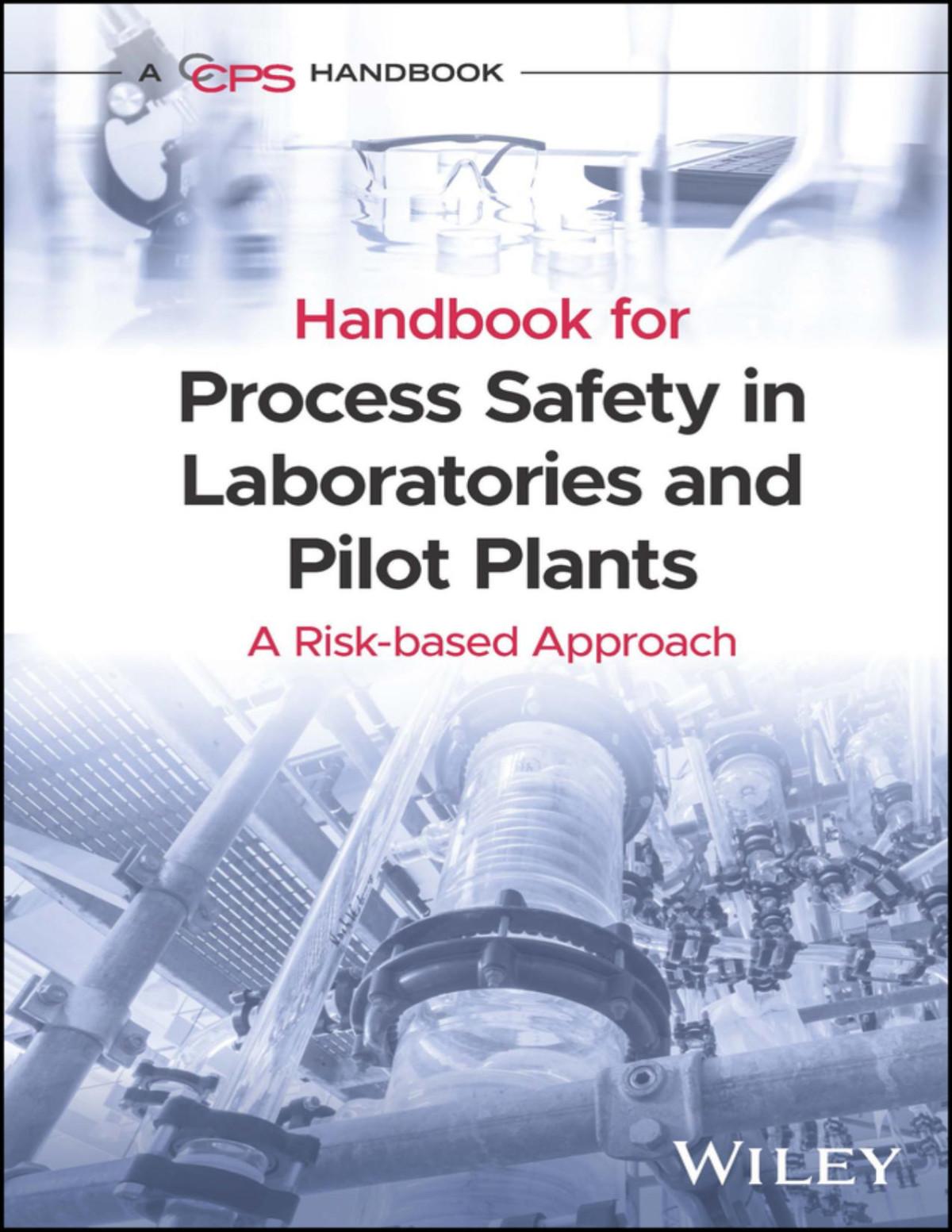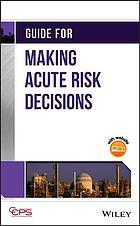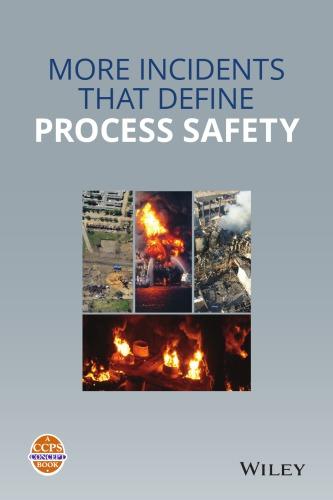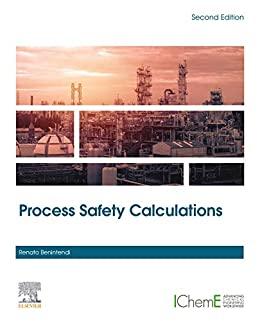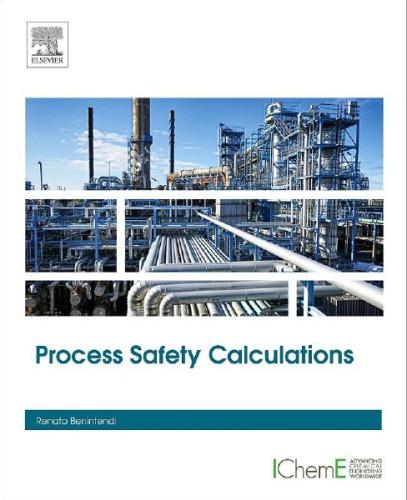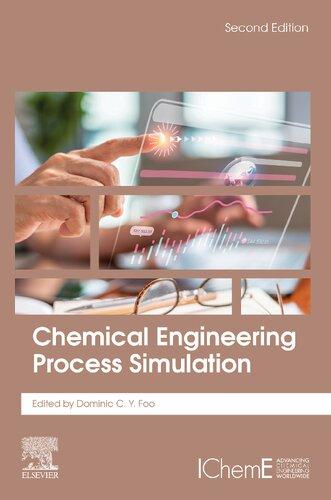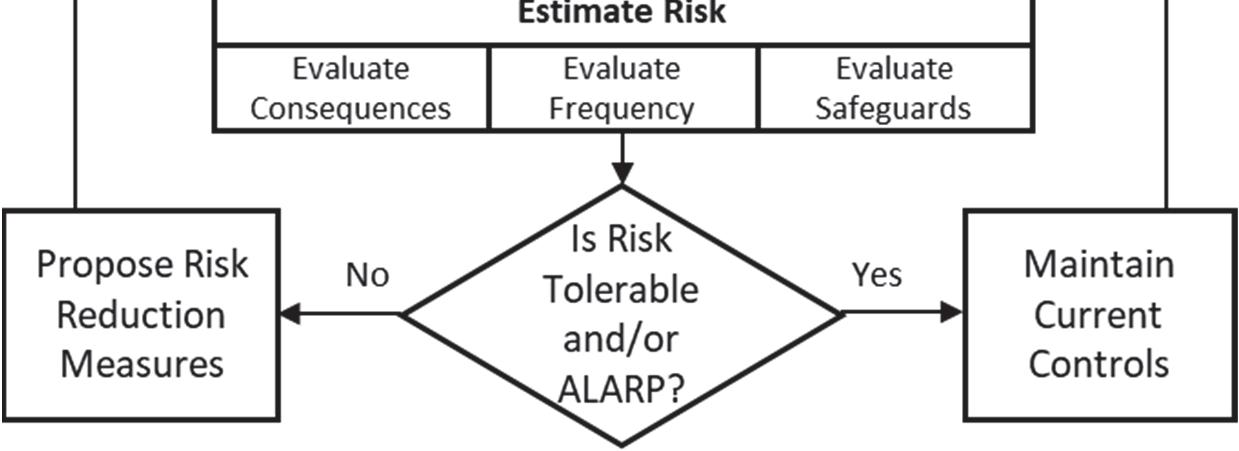GUIDELINES FOR REVALIDATING A PROCESS HAZARD
ANALYSIS
Second Edition
edition first published 2023
© 2023 the American Institute of Chemical Engineers
A Joint Publication of the American Institute of Chemical Engineers and John Wiley & Sons, Inc.
All rights reserved. No part of this publication may be reproduced, stored in a retrieval system, or transmitted, in any form or by any means, electronic, mechanical, photocopying, recording or otherwise, except as permitted by law. Advice on how to obtain permission to reuse material from this title is available at http://www.wiley. com/go/permissions.
The right of CCPS to be identified as the author of the editorial material in this work has been asserted in accordance with law.
Registered Office
John Wiley & Sons, Inc., 111 River Street, Hoboken, NJ 07030, USA
Editorial Office
111 River Street, Hoboken, NJ 07030, USA
For details of our global editorial offices, customer services, and more information about Wiley products visit us at www.wiley.com.
Wiley also publishes its books in a variety of electronic formats and by print-ondemand. Some content that appears in standard print versions of this book may not be available in other formats.
Limit of Liability/Disclaimer of Warranty
In view of ongoing research, equipment modifications, changes in governmental regulations, and the constant flow of information relating to the use of experimental reagents, equipment, and devices, the reader is urged to review and evalusate the information provided in the package insert or instructions for each chemical, piece of equipment, reagent, or device for, among other things, any changes in the instructions or indication of usage and for added warnings and precautions. While the publisher and authors have used their best efforts in preparing this work, they make no representations or warranties with respect to the accuracy or completeness of the contents of this work and specifically disclaim all warranties, including without limitation any implied warranties of merchantability or fitness for a particular purpose. No warranty may be created or extended by sales representatives, written sales materials or promotional statements for this work. The fact that an organization, website, or product is referred to in this work as a citation and/or potential source of further information does not mean that the publisher and authors endorse the information or services the organization, website, or product may provide or recommendations it may make. This work is sold with the understanding that the publisher is not engaged in rendering professional services. The advice and strategies contained herein may not be suitable for your situation. You should consult with a specialist where appropriate. Further, readers should be aware that websites listed in this work may have changed or disappeared between when this work was written and when it is read. Neither the publisher nor authors shall be liable for any loss of profit or any other commercial damages, including but not limited to special, incidental, consequential, or other damages.
Library of Congress Cataloging-in-Publication Data Applied for: Hardback ISBN: 9781119643609
Cover Images: Silhouette, oil refinery © manyx31/iStock.com; Stainless steel © Creativ Studio Heinemann/Getty Images; Dow Chemical Operations, Stade, Germany/Courtesy of The Dow Chemical Company
5.2
6.3.6
LIST OF TABLES
Table
Table
Table
Table
Table
ACRONYMS AND ABBREVIATIONS
AIChE American Institute of Chemical Engineers
ALARP As Low As Reasonably Practicable
ANSI American National Standards Institute
API American Petroleum Institute
ASME American Society of Mechanical Engineers
ATEX ATmospheres EXplosible
BLEVE Boiling Liquid Expanding Vapor Explosion
BMS Burner Management System
BPCS Basic Process Control System
CCPS Center for Chemical Process Safety
CIA Chemical Industry Association
CMMS Computerized Maintenance Management System
DCS Distributed Control System
DHA Dust Hazard Analysis
DMR Damage Mechanism Review
EHS Environment, Health, and Safety
EPA Environmental Protection Agency
ETA Event Tree Analysis
FMEA Failure Modes and Effects Analysis
FTA Fault Tree Analysis
HAZOP Hazard and Operability
HCA Hierarchy of Hazard Controls Analysis
HHC Highly Hazardous Chemical
HIRA Hazard Identification and Risk Analysis
HRA Human Reliability Analysis
ICI Imperial Chemical Industries
IEC International Electrotechnical Commission
IEF Initiating Event Frequency
IPL Independent Protection Layer
ITPM Inspection, Test, and Preventive Maintenance
LOPA Layer of Protection Analysis
MAWP Maximum Allowable Working Pressure
Acronyms and Abbreviations
MCC Motor Control Center
MI Mechanical Integrity
MOC Management of Change
MooC Management of Organizational Change (See OCM)
NFPA National Fire Protection Association
OBRA Occupied Building Risk Assessment
OCM Organizational Change Management
OR Operational Readiness
OSHA Occupational Safety and Health Administration
P&IDs Piping and Instrumentation Diagrams
PFD/PFOD Probability of Failure on Demand
PHA Process Hazard Analysis
PPE Personal Protective Equipment
PLC Programmable Logic Controller
PSI Process Safety Information
PSID Process Safety Incident Database
PSM Process Safety Management
PSSR Pre-Startup Safety Review
QA Quality Assurance
QRA Quantitative Risk Analysis
RAGAGEP Recognized and Generally Accepted Good Engineering Practice
RBPS Risk Based Process Safety
RMP Risk Management Plan
RP Recommended Practice
SCBA Self-Contained Breathing Apparatus
SDS Safety Data Sheet
SIL Safety Integrity Level
SIS Safety Instrumented System
SME Subject Matter Expert
GLOSSARY AND NOMENCLATURE
This Glossary and Nomenclature section contains process safety terms unique to this Center for Chemical Process Safety (CCPS) publication. The CCPS process safety terms in this publication are current at the time of issue. For other CCPS process safety terms and updates to these terms, please refer to the “CCPS Process Safety Glossary” [1].
Complementary Analysis/Analyses: Beyond the core analysis, this includes any additional analyses on specific topics required by policy or regulation to complete the minimum requirements for a process hazard analysis (PHA). Complementary analyses often address topics such as human factors and facility siting, and range in complexity from simple checklist analyses to sophisticated computer modeling. Like the core analysis, any complementary analyses must be included in the scope of a revalidation.
Core Methodology/Core Analysis: This is the primary method used to identify, evaluate, and document process hazards and their consequences and risk controls. Although other PHA methods are available, one of the following three techniques is most commonly used: Hazard and Operability (HAZOP) Study, What-If/Checklist, or Failure Modes and Effects Analysis (FMEA).
Facilitator/Leader/Study Leader: Universally, PHA revalidation teams must include at least one person knowledgeable in the hazard analysis methodology being used. The terms “facilitator,” “leader,” and “study leader” are used interchangeably in this book, as they are in general practice, but the person’s actual role is a blend of both facilitator and study leader. As facilitator, they should engage all other team members in the correct application of the chosen hazard analysis technique and make the work process easier. They should also ensure that the PHA team follows the relevant rules and guidelines specified for the study. Simultaneously, they should lead the team to complete the revalidation efficiently and accurately without stifling the team’s imagination and curiosity as they try to identify hazards of the process.
Hazard Identification and Risk Analysis (HIRA): This collective term encompasses all activities involved in identifying hazards and evaluating risk at facilities, throughout their life cycle, to make certain that risks to employees, the public, or the environment are consistently controlled within the risk tolerance of the organization. PHA revalidation, as described in this book, is also generally applicable to the revalidation of HIRAs.
Incident: Use of the single term “incident” throughout this book is intended to include of the incident definitions listed in the CCPS glossary definition. These
Glossary and Nomenclature xiii
include “catastrophic incident,” “incident,” “near-miss incident,” and “process safety incident/event.”
Process Hazard Analysis (PHA): This review is an organized effort to identify and evaluate hazards associated with processes and operations to enable their control. Normally, the analysis involves use of qualitative techniques to identify and assess the significance of hazards. Reviewers judge risks and develop appropriate recommendations. Occasionally, quantitative methods are used to help prioritize risk reduction. In this book, the term “PHA” encompasses all the activities involved in creating and revalidating the resulting PHA document.
Process Safety Management (PSM) System: A management system that focuses on prevention of, preparedness for, mitigation of, response to, and restoration from catastrophic releases of chemicals or energy from a process associated with a facility. In this book, the term “PSM” broadly encompasses management systems anywhere in the world with similar intent, regardless of their official name, whether required by regulatory authorities or by organizational policies. PSM issues related to a specific jurisdiction, such as the United States Occupational Safety and Health Administration (OSHA) PSM, are noted in this book.
Semi-Quantitative Risk Analysis: This evaluation uses a risk matrix with a numeric frequency scale and a descriptive, qualitative consequence scale. Any risk analysis based on such a matrix is inherently semi-quantitative (part numeric, part descriptive). This terminology is sometimes incorrectly used to describe a simplified, but fully numeric, QRA.
Simplified Quantitative Risk Analysis/Simplified Process Risk Assessment:
Quantitative risk analysis (QRA) involves the systematic development of numerical estimates of the expected frequency and/or severity of potential consequences associated with a facility or operation. The estimation process may be based on conservative rules and order-of-magnitude data to simplify the analysis. Simplified QRA techniques, such as Layer of Protection Analysis (LOPA), are typically used to identify whether the risks of evaluated loss scenarios are managed to tolerable levels.
Supplemental Risk Assessment: This includes any additional analyses used to improve the quality and consistency of risk judgments in a PHA. Common techniques range from (1) simple categorization on a risk matrix to (2) simplified risk analysis techniques such as LOPA and bow tie analysis to (3) detailed QRAs. Supplemental risk assessments are typically included in the scope of a revalidation to be consistent with the requirements of the facility owner and applicable regulations.
ACKNOWLEDGMENTS
The American Institute of Chemical Engineers (AIChE) and the Center for Chemical Process Safety (CCPS) express their gratitude to all members of the Revalidating Process Hazard Analyses Second Edition subcommittee and their CCPS member companies for their generous efforts and technical contributions in the preparation of this book.
The chair of the subcommittee was Laura Acevedo Turci from 3M. Warren Greenfield was the CCPS consultant. The subcommittee also included the following people who participated in the writing of this Guidelines book:
Alok Khandelwal Shell
Curtis Clements Chemours
Jennifer Bitz CCPS
Jordi Costa Sala Celanese
Lisa Parker Braskem
Manuel Herce DuPont
Marty Timm Praxair - Linde - Retired
Michael Hazzan AcuTech Consulting
Mohammad Baig Bayer
CCPS especially wishes to acknowledge the contributions of the principal writers from ABSG Consulting Inc. (ABS Consulting):
Derek Bergeron
Bill Bradshaw
Don Lorenzo
The writers wish to thank the following ABS Consulting personnel for their technical contributions and reviews: Tom Williams and David Whittle provided technical review of the book. Lynn Purcell edited the manuscript. Susan Hagemeyer helped prepare the final manuscript for publication.
Acknowledgements xv
Before publication, all CCPS books are subjected to a thorough peer-review process. CCPS also gratefully acknowledges the thoughtful comments and suggestions of the following peer reviewers. Their work enhanced the accuracy, clarity, and usefulness of this Guidelines book. Although the peer reviewers have provided many constructive comments and suggestions, they were not asked to endorse this book and were not shown the final manuscript before its release.
Ahmad Hafiz Zeeshan Tronox Australia
Allison Knight 3M
Bernard Groce Calumet Specialty
Dan Sorin Novachem
Denise Chastain-Knight exida
Don Connolley aeSolutions
Felix Azenwi Fru National Grid
Gill Sigmon AdvanSix
James Martin Corteva™ Agriscience
Kristine M. Cheng Chevron
Lisa Long OSHA
Matias Massello Process Improvement Institute
Michell LaFond Dow
Michelle Brown FMC
Muddassir Penkar Heartland Petrochemical Complex Interpipeline
Nick Ashley W.R. Grace and Company
Palaniappan Chidambaram DSS
Rizal Harris Wong Petronas
Robert Feuerhake Lanxess
Ruel Ruiz 3M
Scott E. Swanson Intel
Tekin Kunt PSRG
PREFACE
The American Institute of Chemical Engineers (AIChE) has helped chemical plants, petrochemical plants, and refineries address the issues of process safety and loss control since 1967.
The Center for Chemical Process Safety (CCPS), a directorate of AIChE, was established in 1985 to develop and share technical information for use in the prevention of major chemical accidents. CCPS is supported by a diverse group of industrial sponsors in the chemical process industry and related industries who provide the necessary funding and professional guidance for its projects. The CCPS Technical Steering Committee and the technical subcommittees oversee individual projects selected by the CCPS. Professional representatives from sponsoring companies staff the subcommittees and a member of the CCPS staff coordinates their activities.
Since its founding, CCPS has published many volumes in its “Guidelines” series and in smaller “Concept” texts. Although most CCPS books are written for engineers in plant design and operations and address scientific techniques and engineering practices, several guidelines cover subjects related to chemical process safety management. A successful process safety program relies upon committed managers at all levels of a company, who view process safety as an integral part of overall business management and act accordingly.
This book is an update of the 2001 book “Revalidating Process Hazard Analyses”. In 21 years since the publication of the first edition, PHA and PHA revalidation have evolved, and the methods for conducting them have changed and improved. This updated edition addresses the complementary analyses and supplemental risk assessments that often are incorporated into PHAs. It reflects the knowledge gained by the CCPS, writers, and the project committee members, who collectively, have more than 100 years of practical experience in conducting and revalidating PHAs.
This book was written to enhance the knowledge and provide insight and guidance to those who are involved with the planning and execution of PHAs and are responsible for updating and revalidating PHAs. Multiple audiences should find this book useful. Those who manage the PHA program will find guidance for resources and timing. Those who must determine the type of revalidation necessary will find tools for analyzing the past PHA and related studies. PHA teams will find checklists and other tools in the appendices for use during the study.
DEDICATION
Updating and Revalidating Process Hazard Analyses
Is dedicated to Walt Frank
Walt Frank is a process safety professional with a wide range of experience and expertise that is helping to improve process safety worldwide.
From his early entry into process safety at DuPont through consulting at ABS and later as President of Frank Risk solutions, Walt has always been dedicated to sharing process safety knowledge and expertise through his many contributions to both NFPA and CCPS.
Walt was a primary writer for the first edition of the Revalidating Process Hazard Analyses. He has also been a key contributor to several other CCPS books. In addition, he is the current chair of the CCPSC Exam committee and is a key contributor to the CCPS Golden Rules for Process Safety project.
Walt is often the driving force that helps teams focus on the key process safety aspects requiring development and presentation in a clear and precise manner. He has a keen eye for details and sets similar expectations for his colleagues and team members. He is persistent in pursuing perfection.
Walt is a Registered Professional Engineer, AIChE Fellow, CCPS Fellow, Certified Process Safety Professional (CCPSC) and a CCPS Emeritus. CCPS is proud to dedicate this book to Walt in recognition for all he has given and continues to give, to the process safety community.
Anil Gokhale & Warren Greenfield
INTRODUCTION
OBJECTIVE OF THIS BOOK
For years, formal process hazard analyses (PHAs) have been performed on processes handling hazardous materials, and most companies have included requirements for the conduct of PHAs in their process safety management (PSM) programs.
Most company PSM programs also include requirements to revalidate the PHA periodically. Such requirements are intended to ensure the PHA for a process is complete, up to date, and thoroughly documented, considering the changes and incidents that have occurred in the process and the operating experience gained since the prior PHA was conducted. In jurisdictions where PHAs are required by regulation, periodic revalidation is usually required to maintain regulatory compliance.
Because the efforts to revalidate the PHA can involve a significant investment of time and resources, it is important that the revalidation effort be thoughtfully organized, conducted, and documented. This book addresses the need, identified by the CCPS, for supplemental guidance with respect to considerations unique to the PHA revalidation task.
SCOPE OF THIS BOOK
This book provides an organized approach, and several tools, to revalidate a PHA. However, it does not provide a “one-size-fits-all” approach for revalidation. Neither is it intended to provide the “one true solution” to the task. Readers and companies should develop procedures based upon an evaluation of their specific requirements. Although the concepts in this book could be adapted for revalidation of other studies (e.g., security analysis and financial risk analysis), the book was written exclusively with the intent of revalidating a PHA and the documentation/studies directly associated with a PHA. Revalidation of other stand-alone analyses is outside the specific scope of this book.
This book assumes that the reader is familiar with the conduct of a PHA. While some introductory material on general PHA activities, methodologies, and risk assessment is provided in Chapter 1, this book is not intended to be an instructional text covering the general conduct of a PHA or application of supplemental risk assessment techniques (such as Layer of Protection Analysis [LOPA] or bow tie analysis).
xx Guidelines for Revalidating a Process Hazard Analysis
This book is a supplement to the CCPS book Guidelines for Hazard Evaluation Procedures [2, p. 8] and is premised on the same concept stated in the book:
This book does not contain a complete program for managing the risk of chemical operations, nor does it give specific advice on how to establish a hazard analysis program for a facility or an organization. However, it does provide some insights that should be considered when making risk management decisions and designing risk management programs.
This book outlines a demonstrated, common-sense approach for resourceeffective PHA revalidation. This approach first examines a number of factors, such as PHA requirements, the quality of the prior PHA, and the operating experience gained since the prior PHA (including changes and incidents that have occurred). A revalidation approach is developed based upon this input. The revalidation concept described in this second edition has been updated based on experience and knowledge gained since the first edition was published over 20 years ago.
HOW TO USE THIS GUIDELINES BOOK
To use this book effectively for PHA revalidation, it is helpful to follow the chapters in sequence. The book progresses through each key/major step in the process of revalidating a PHA.
Chapter 1 – Overview of the PHA Revalidation Process explains the role of PHA and PHA revalidation in understanding and managing risk. It describes two revalidation approaches and the typical analytical tools used in revalidation activities.
Chapter 2 – PHA Revalidation Requirements explains the external and internal requirements that must be satisfied by a periodic PHA revalidation.
Chapter 3 – Evaluating the Prior PHA explains how to identify deficiencies in the prior PHA (with respect to current requirements) and to evaluate its usability in revalidation activities.
Chapter 4 – Evaluating Operating Experience Since the Prior PHA explains how to gather and evaluate information (arising from process changes, equipment changes, procedure changes, organizational changes, new research, incident investigations, etc.) that could materially alter the risk judgments documented in the prior PHA.
Chapter 5 – Selecting an Appropriate PHA Revalidation Approach explains how to use the knowledge and insights gained from evaluating the prior PHA and operating experience to select a thorough and efficient revalidation approach.
Chapter 6 – Preparing for PHA Revalidation Meetings explains how to assemble the resources necessary to conduct revalidation meetings and how to document them successfully.
Chapter 7– Conducting PHA Revalidation Meetings explains how to facilitate the use and interaction of resources to achieve the revalidation objectives.
Chapter 8 – Documenting and Following Up on a PHA Revalidation explains how to create a revalidation report likely to meet applicable requirements and how to help ensure elevated risks discovered during the revalidation are communicated and resolved.
Appendices – Sample Checklists are available in the appendices for use in PHA revalidation. Electronic versions of the checklists in the appendices are available at
www.aiche.org/ccps/publications/reval2ed
Password: revalbooked2
REVALIDATION PROCESS
A process hazard analysis (PHA) is foundational in helping facility management implement and maintain all four of the accident prevention pillars identified within the Guidelines for Risk Based Process Safety (RBPS) [3, p. 3]. It may also be required to comply with applicable process safety regulations and internal company requirements. The pillars are listed here and discussed in Section 1.8:
• Commit to process safety
• Understand hazards and risk
• Manage risk
• Learn from experience
Once management has committed the organization to process safety, the next step is to understand what hazards need to be managed. In 2008, the Center for Chemical Process Safety (CCPS) updated and republished its Guidelines for Hazard Evaluation Procedures book, which includes the following definition of a hazard [2, p. 51]:
A hazard is a physical or chemical characteristic that has the potential for causing harm to people, property, or the environment. Thus, hazard identification involves two key tasks: (1) identification of specific undesirable consequences and (2) identification of material, system, process, and plant characteristics that could produce those consequences.
The RBPS term “Hazard Identification and Risk Analysis (HIRA)” encompasses the application of a broad range of analytical tools, including those used in a PHA to identify hazards and evaluate risk. A PHA report documents the results from a particular application of HIRA tools intended to meet specific requirements for managing risk in a process. These requirements can be internal (e.g., company policy) and/or external (e.g., regulatory). Over the life of a process, these requirements and their interpretation may change. There may also be external changes, such as community development or rainfall patterns that affect risk. The company’s experience with and understanding of the process will increase,
Guidelines for Revalidating a Process Hazard Analysis
and the company will likely make changes to the process itself. Thus, there are also requirements for periodic revalidation of a PHA to incorporate and address such changes.
1.1 WHAT IS A PHA AND WHAT IS A PHA INTENDED TO ACCOMPLISH?
A PHA involves a variety of activities intended to identify, evaluate, and document the hazards in a chemical process. Those hazards may be related to equipment design, normal or transient operating practices and procedures, maintenance practices, human factors, facility siting, external events, or other areas of concern. (The unique hazards associated with transient operations are discussed in the CCPS book Guidelines for Process Safety During the Transient Operating Mode: Managing Risks During Process Start-ups and Shut-downs [4].) The resulting PHA report also documents the PHA team’s judgments related to the design, operation, and maintenance of a process that could lead to accidental chemical releases, fires, explosions, or other loss events. This information is very valuable in the planning and design of all the other RBPS elements. Most importantly, the PHA report documents the team’s analysis of those loss scenarios that may pose an elevated risk to personnel, property, and/or the environment, key safeguards, and any team recommendations for further risk reduction.
As shown in Figure 1-1, PHA activities typically involve the following five steps:
1. Identify hazards (potential for adverse consequences), including characteristics of the following:
• Process chemicals (e.g., toxicity, reactivity, or flammability)
• Process equipment (e.g., design specifications, layout, or spacing) affecting the likelihood or severity of adverse consequences
• Process operations (e.g., potential for high temperature, high pressure, or contamination)
• Siting (e.g., locations of occupied structures or climate) affecting the likelihood or severity of adverse consequences
2. Identify specific hazardous events (e.g., catastrophic equipment failure, loss of primary containment of hazardous material, uncontrolled energy release) that could result in adverse consequences due to potential causes involving:
• Equipment performance gaps
• Human performance gaps
• External events (e.g., change in process inputs, loss of essential utilities, or natural disaster)
3. Judge risk by evaluating the following:
• Worst credible case magnitude (severity) of adverse consequences
• Frequency of events that could result in those consequences (without taking credit for any risk controls)
• Loss scenario frequencies, taking credit for any relevant risk controls (or safeguards)
4. Decide whether the level of risk is tolerable and/or as low as reasonably practicable (ALARP)
5. If risk is not ALARP, propose risk reduction alternatives (recommendations)
Figure 1-1 Typical PHA Flowchart
1.2 OVERVIEW OF TYPICAL PHA ACTIVITIES
While many factors contribute to a high-quality PHA, proper selection of the PHA core methodology is critical to a successful PHA.
1.2.1 PHA Core Methodology
The PHA is built upon one or more core analytical methodologies. The most commonly used techniques in the chemical/process industries are:
• Hazard and Operability (HAZOP) Study
• What-If/Checklist Analysis
• Failure Modes and Effects Analysis (FMEA)
A detailed discussion and comparison of the PHA core methodologies is beyond the scope of this book. Readers unfamiliar with the various techniques may refer to the CCPS book Guidelines for Hazard Evaluation Procedures for guidance on technique selection [2, pp. 99-202]. Descriptions of the more widely used core methodologies have been abridged from the aforementioned book and are provided. Note that any technique used as a core methodology must be applied by a team with all the skills required to perform a PHA.
HAZOP Study. The HAZOP technique is the most often used core methodology. HAZOP is a brainstorming approach involving an interdisciplinary team. The purpose of a HAZOP Study is to review a process or operation carefully and systematically to determine whether deviations from the design or operational intent can lead to undesirable consequences. The team leader, knowledgeable in the methodologies being applied, systematically prompts the team to consider plausible deviations within specific equipment groupings and/or batch steps (commonly called “nodes” or “sections”) of the process. Deviations are formed by combining a fixed set of “guide words" (e.g., no, more, less) with the relevant process parameters in that node (e.g., flow, temperature, pressure) and/or the batch step intentions (e.g., adding chemicals in a specified sequence). For example, the guide word "No" combined with the process parameter "Flow" results in the deviation "No Flow.” This technique can be used for continuous or batch processes and can be adapted to evaluate written procedures for normal or transient conditions.
For each deviation, the team (1) determines if any consequences of interest would result from credible causes of deviation, (2) identifies engineering and administrative safeguards and controls protecting against the deviation, (3) evaluates risk associated with the deviation, and (4) if necessary, makes
recommendations to reduce the likelihood of the deviation or the severity of the consequences.
Similar to the What-If/Checklist technique discussed in this section, a HAZOP is often paired with checklists or other “complementary analyses” to further evaluate specific concerns (e.g., human factors, facility siting).
What-If/Checklist Analysis. The What-If Analysis technique alone, or the Checklist Analysis technique alone can be an appropriate core methodology for some processes. However, in most cases, the two are combined to take advantage of both the creative, brainstorming questioning of the What-If Analysis method and the systematic questioning of the Checklist Analysis method. What-If/Checklist is often used for lower hazard processes, simpler processes, and processes that do not involve chemical reactions, such as storage or transfer systems. What-If/Checklist is also appropriate for processes and activities that do not have rigidly defined material and energy flow paths or that have hazards not directly tied to process parameters such as flow, level, temperature, and pressure. Laboratory and pilot plant operations are often candidates for What-If/Checklist Analysis. This technique is often the first hazard evaluation method performed on a process (e.g., during early design stage of a new process), and as such, it can be a precursor for future, more detailed, studies.
In the What-If portion of the analysis, the team asks questions or voices concerns about possible undesired events. Their concerns (usually phrased in the form of what if? questions) are primarily formulated to identify hazardous events or specific loss scenarios that could produce an adverse consequence. There may be no specific pattern or order to these questions, unless the leader systematically directs the team to focus on a particular portion of the process and/or a particular category of questions (process variable deviations, equipment failure modes, operating errors, etc.). The questions can also address any abnormal condition related to the plant or procedure, whether caused by human or equipment performance gaps, or by external events (e.g., floods, high winds, vehicle impacts, dropped objects).
In the checklist portion of the analysis, the team primarily relies on a standard list(s) of questions developed based on experience with similar chemicals, equipment, processes, and/or activities. Frequently, checklists are created by simply organizing information from current relevant codes, standards, and regulations. The standard questions may be modified to address specific concerns about the subject process.
Guidelines for Revalidating a Process Hazard Analysis
Regardless of the origin of a particular What-If or Checklist Analysis question, the analysis prompts the hazard evaluation team to consider and document potential abnormal situations, their consequences, and the risk controls. The team judges whether the risks are controlled within the organization’s tolerance, and if not, makes recommendations for improvement.
FMEA. The FMEA technique is a systematic analysis of single component or functional failure modes and each failure mode’s potential effect(s) on a system. For each failure mode, the team (1) determines if any consequences of interest would result, (2) identifies engineering and administrative safeguards and controls protecting against the failure mode, (3) evaluates risk associated with the failure mode, and (4) if necessary, makes recommendations to reduce the likelihood of the failure mode or the severity of the consequences.
The FMEA method is best suited for analysis of mechanical and electronic systems, so it is sometimes selected as the core methodology for processes involving compressors, centrifuges, or highly automated systems. However, FMEA is poorly suited for processes involving reactive chemistry or human interactions where the PHA needs to consider human errors as causes of hazardous events. Therefore, the overwhelming majority of PHA teams use the HAZOP or the What-If/Checklist combination as their core methodology. FMEA is more often applied as a complementary analysis for specific, complex equipment to generate a systematic reference list of components, their failure modes and effects, and prioritized maintenance task lists for increasing equipment reliability.
1.2.2 PHA Complementary Analyses
In a PHA, complementary analyses are used by the PHA team in addition to the core methodology to help provide focus and direction on specific topics. The two most common complementary analyses address human factors and facility siting. These complementary analyses are often reviews of checklists that have been developed by a company or adapted from industry publications and standards. However, complementary analyses can involve much more sophisticated studies such as computational fluid dynamic analysis and modelling of vapor dispersion or finite element analyses of structural response to overpressure and dynamic loads. While the selection, development, and application of these analyses are outside the scope of this book, it is important to note that complementary analyses required by a regulation or company policy must also be revalidated.
